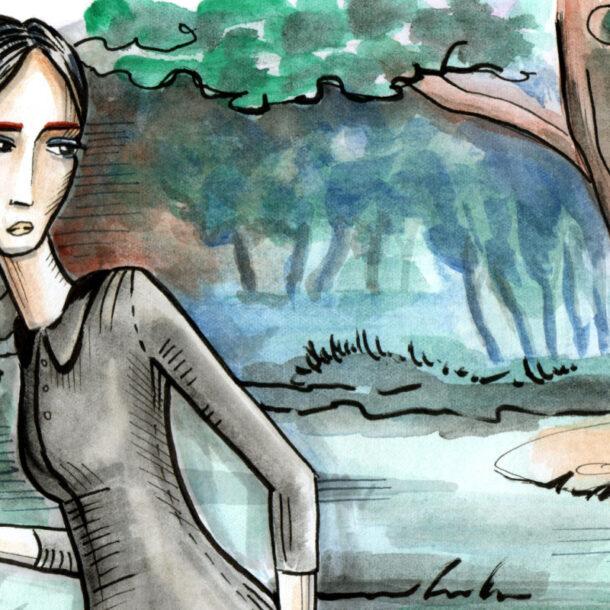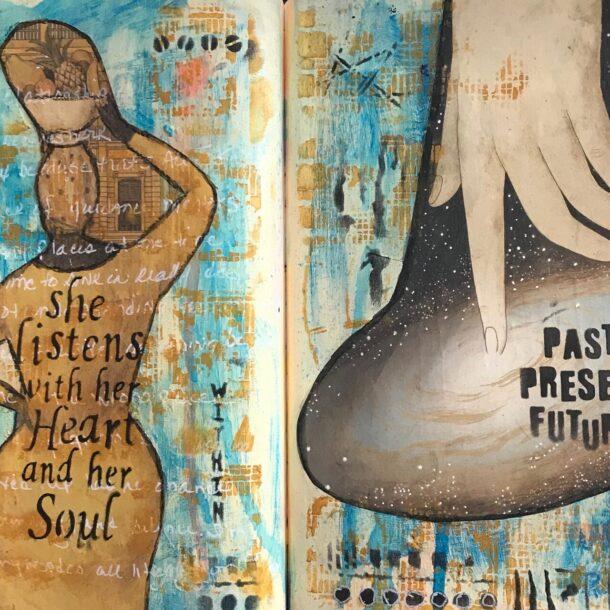
Journey to the Self: Jung’s Individuation and the Power of Visual Journaling
An Overview of Jung’s Individuation Process
The individuation process is a central concept in the analytical psychology of Carl Gustav Jung. At its core, it describes the journey toward self-realization, wherein a person strives to integrate and balance the diverse aspects of their unconscious into their conscious life, culminating in the realization of their true Self. For Jung, individuation is not just a process of personal growth but a journey toward wholeness.
Origins and Significance
Jung believed that every individual possesses both a personal unconscious, filled with their unique memories and experiences, and a collective unconscious, populated with archetypes or universal symbols and patterns that have existed across cultures and eras. The individuation process facilitates the integration of these two realms, allowing a person to acknowledge and incorporate the deeper, often hidden aspects of their psyche.
Stages of Individuation
Although Jung did not strictly define a set number of stages in the individuation process, the journey can be seen as comprising several key phases:
1. Confrontation with the Shadow: This is often the first step in the individuation journey. The ‘Shadow’ in Jungian psychology refers to the unconscious part of the personality which contains repressed weaknesses, desires, and instincts. Recognizing, confronting, and integrating the shadow is vital. By embracing one’s flaws and dark sides, one moves closer to a state of wholeness.
2. Encounter with the Anima or Animus: The Anima (in men) and Animus (in women) represent the unconscious feminine and masculine aspects, respectively. These archetypes play crucial roles in how we relate to the opposite sex and understand gender within ourselves. By reconciling with and integrating these aspects, individuals can achieve a more harmonious relationship with their inner Self and others.
3. Engagement with the Persona: The ‘Persona’ is the social mask that one wears in public – it’s the role we play. While it’s necessary for social function, over-identification with the persona can distance one from one’s authentic Self. Shedding or adjusting this mask is a crucial part of the individuation process.
4. Experience of the Self: Beyond the archetypes mentioned above, at the center of the collective unconscious is the archetype of the Self. It embodies the unified unconsciousness and consciousness of an individual. Encountering the Self signifies a moment of profound self-realization and represents the culmination of the individuation process.
Challenges and Transformation
Individuation is by no means an easy journey. It often involves confronting deep-seated fears, traumas, and preconceived notions about oneself and the world. Yet, this process also brings about profound transformation. As one integrates the various aspects of the unconscious, there’s potential for increased creativity, a deeper understanding of oneself, and more genuine relationships with others.
Moreover, individuation contributes to a greater sense of purpose and meaning in life. Jung believed that this journey towards wholeness was integral to the human experience and that ignoring or avoiding it could lead to feelings of emptiness, depression, or a general sense of being unfulfilled.
Carl Jung’s concept of individuation offers a deep and holistic understanding of personal growth and self-realization. While the journey is individual and unique to each person, the ultimate aim remains consistent: to achieve a harmonious balance between the conscious and unconscious realms and to realize one’s true potential and authentic Self.
Visual Journaling and the Individuation Process
Visual journaling, often understood as the practice of combining imagery and words in a journal format, is a powerful tool for self-expression and introspection. Whether through sketches, paintings, collages, or other visual means, this form of journaling transcends the limitations of verbal language, directly tapping into the unconscious’s symbolic realm. Visual journaling can be a potent vehicle for self-exploration and transformation when viewed through the lens of Carl Jung’s individuation process.
1. Direct Access to the Unconscious:
One of the primary benefits of visual journaling lies in its ability to bypass the analytical, conscious mind. Visual symbols and images often emerge spontaneously, much like the content of dreams, offering raw insights into the unconscious realm. In this way, visual journaling can illuminate the hidden facets of the shadow, making them tangible and easier to engage with.
2. Encountering Archetypes:
Jung believed that the collective unconscious is populated with universal symbols or archetypes. As individuals engage in visual journaling, they might find certain symbols consistently emerging — these could be representations of the Anima, Animus, or even the Self. Recognizing and reflecting on these symbols can facilitate a deeper understanding and integration of these archetypal energies.
3. Externalizing the Persona:
Visual journaling allows for exploring and depicting various roles one might play in daily life. By illustrating these roles, individuals can create a visual representation of their persona, helping them understand its components and, in turn, discerning which elements are authentic versus those that are mere societal adaptations.
4. Active Imagination:
Jung introduced the technique of active imagination as a means of dialoguing with the unconscious. Visual journaling can be seen as a form of this technique. By creating imagery, one is actively engaging with the inner world, allowing for a dialogue between the conscious and unconscious aspects of the psyche. This dialogue fosters integration and growth.
5. Catharsis and Emotional Release:
The very act of creating can be therapeutic. Visual journaling offers a safe space to express and process emotions, facilitating catharsis. Individuals can gain perspective by externalizing emotions onto paper or canvas, making it easier to address and integrate these feelings.
6. Tracking Progress:
A visual journal serves as a tangible record of one’s journey. Over time, individuals can revisit earlier entries, reflecting on their growth and the evolution of their inner landscapes. This documentation can be immensely validating, reinforcing the progress made during the individuation process.
Incorporating visual journaling into the journey of individuation provides a dynamic and expressive outlet for self-exploration. The visual realm, rich in symbolism and free from the constraints of verbal language, offers direct access to the deeper layers of the psyche. For those embarking on the path of individuation, visual journaling can serve as both a compass and a mirror, guiding introspection and reflecting the ever-evolving Self. Through this practice, the intricate dance between the conscious and unconscious is vividly illustrated, making the intangible journey of individuation tangibly visible.
Are you looking for more inspiration? Check out our online classes here.

Hi! I'm Terri Altschul
Visual Journaling is a soulful, transformational, and healing process. My aim is to support your journey of individuation and personal growth through this unique process of self-inquiry + art materials. I look forward to meeting you!
Join my email list for inspiration and soul guidance.
We are delighted to invite you on a journey of self-discovery, personal growth, and creative expression where transformational coaching and captivating visual journaling converge!




